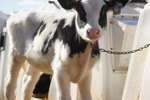
One of husbandry's biggest draws is the chance to watch nature take its course in the animal kingdom. New life is brought to the barn or farmstead regularly, as nature works to introduce foals, calves, chicks and the like to a bustling new world. Sometimes, however, nature sidesteps our expectations, such as when a mother pygmy goat abandons a baby kid to die, and in times like these it falls to humans to intervene.
Why Does It Happen?

It's heartbreaking to observe a newborn pygmy kid stretching to nurse, only to be refused milk by the dam (mother goat) who birthed him, but it occurs often enough to be considered a regular part of kidding (a goat's birthing process). Over the years goat keepers have come up with myriad reasons for this occurrence—dam confusion, a lack of bonding, poor mothering—but whatever the cause, the condition requires human intervention to save the kid's life.
Prevention

The saying “An ounce of prevention is worth a pound of cure” definitely applies here. When a goat kids a newborn, she often fails to notice she's given birth; as immediate bonding is key to “jump-starting” the mothering instinct, a goat keeper needs to move the baby in front of the mother to encourage cleaning. Cleaning is the critical first step in the bonding process that leads to nursing. Some pygmy goat keepers even place a bit of birthing fluid on the mother's nose.
Feeding

If a mother pygmy refuses to nurse, the keeper must bottle-feed to prevent kid death. Bottles should contain warm fluids (cold can cause digestive distress), and the goat should be fed with his head tilted back, a natural feeding position that allows milk to flow to his abdomen. One to 3 ounces of colostrum (first milk—artificial is available) should be given in the first hour and every three hours after that for the first day. On the second and third day, 2 to 3 ounces of colostrum or fresh/frozen goat's milk (raw or whole cow's milk will work) are fed eight to 10 times a day. During the first week, 4 to 5 ounces of milk are fed seven to eight times day, then six times a day for the following two weeks. For two months following this, 6 to 8 ounces of milk are fed with decreasing frequency, starting at five times a day and working toward a weaned 2-month-old kid. Patience is a key trait, as kids don't always take bottles easily.
Additional Care

While feedings are crucial, additional care is also required. Dams will often abandon sickly kids, so monitor the baby goat to ensure a normal rectal temperature of 101.5 to 103.5 Fahrenheit. Place a goat with low body temperature in very warm water; towel- and blow-dry, then wrap loosely in a towel and place in a box with a towel-covered heating pad on low. In cold weather, use a heat lamp.
References
Photo Credits
-
Thomas Northcut/Photodisc/Getty Images
Writer Bio
Rodney Wilson is owner and manager of Goldfinch Farm in central Kentucky, where he oversees veterinary and management practices for a diverse group of animals, from dogs and cats to pigs and chickens. He's written professionally since 2001, with articles appearing in such publications as The Cincinnati Enquirer, CiN Weekly, Baby Guide and Akron Life.




